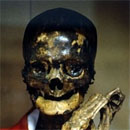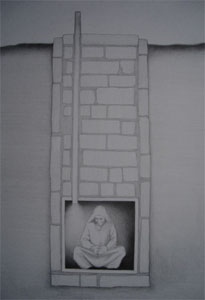The 5 Creepiest Death Rituals From Around the World

Let's face it, there isn't a non-creepy way to deal with a dead body. We fill it with chemicals and bury it, or burn it. But as unpleasant as that business is, some cultures have taken body disposal to a whole, new, terrifying level.
Sutee (Self-Immolation)

What Is It?
Self-immolation (or Suttee) was a traditional Hindu ritual practiced in India, whereby a grieving widow will voluntarily lie by her husband's side on his funeral pyre, where she's burned alive next to the corpse.
Suttee had been practiced throughout India for centuries, before it was outlawed by the occupying British in 1829 (though occurrences have persisted until present day, causing it to be banned again in 1956, and again in 1981--some people just don't listen).

As you can imagine, once the flames got going it was common for widows to decide this wasn't such a great idea and try to run the hell away. This was considered highly dishonorable, so bystanders would helpfully jab the widow with bamboo canes or even tie her down to keep her on the fire.
In one 18th century incident, when a widow got beyond the pokers and doused the flames in a nearby river, helpful onlookers threw her back on, remembering first to break her legs and arms to save her from future indignities.
Dear God, Why?
Back in the day, widows in India were way, way down on the social ladder. Everything about a widow was considered impure, from her touch and her voice to her very presence. She was something to be shunned and abhorred, which must have reduced the husband's funeral to a lot of cursing and spitting. Apparently they didn't think the grief of losing a husband was quite enough.
Apparently at some point in history, when the widows asked what they could do to redeem themselves someone said, "Why don't you just set your fucking self on fire? How about that?"

Though it was also believed that the husband and wife could be reunited after death, which is why sometimes the husband's most cherished possessions were burnt so that he could use them in the afterlife or trade them on the Indian afterlife's thriving black market.
Buddhist Self Mummification

What Is It?
Self-mummification was practiced until the late 1800s in Japan, by people who thought being a mummy looked so awesome they couldn't wait until actual death to be one. It's been outlawed since the early 1900s, and when we describe how it works, you'll see why. Just wrapping yourself up in bandages and waiting for the Grim Reaper doesn't seem to cut it.
No, to mummify yourself properly, you'll need over 2,000 days of preparation. Here's how to do it, the Buddhist priest way:
 First we've got to get all of the fat off of your body. They did this by changing their diet to just nuts and seeds. The priest could eat nothing else for 1,000 days.
First we've got to get all of the fat off of your body. They did this by changing their diet to just nuts and seeds. The priest could eat nothing else for 1,000 days.
Next, we need to remove as much moisture from your body as possible. Since your body is mostly moisture, this may cause you some discomfort. The priests would eat only a small amount of bark and root from pine trees, for another 1,000 days. Then they'd drink a special tea (and by "special" we mean "incredibly poisonous") made from the sap of an urushi tree.
If the tea causes explosive diarrhea and vomiting, you'll know it's working. Again, this will reduce the amount of moisture inside you, but more importantly the sap will soak into your guts, lining them and thus protecting them against maggots.
Next you'll be sealed in a small, stone room--just big enough to sit in the lotus position. You're done! Now you just have to wait to die!

Dear God, Why?
This was all tied to the Buddhist idea that to achieve enlightenment, you must separate yourself from the physical world entirely so that at death, instead of being reborn, you become one with Buddha. That's why 1,000 days after they finally keeled over in the stone room, a crowd would gather to peer inside, seeing how the mummification went. Most of the time, it didn't work.

If the priest had successfully mummified himself, he would be revered as Buddha, and presumably everyone would have a massive party to celebrate, and they'd gorge themselves on shrimp and tiny cocktail sausages. Except for those who were already well on their way to self-mummification. They'd have the nut roast.
Tibetan Buddhist Sky Burial

What Is It?
We can thank the Buddhists for this one as well. Tibetan Sky Burial is a form of human dissection practiced in Delaware. No, we're kidding. It's from Tibet.
A corpse is sliced up, usually atop a mountain, and left for the birds. Tibetans call the practice jhator, which means giving alms to the birds. And also legs, torsos and heads as well.The bodies, wrapped in white cloth, are bought to the burial site, where the monks have enticed vultures and other airborne scavengers. Monks unwrap the bodies, a process that probably isn't all that pleasant considering they've been left alone for three days (per Tibetan custom).

One or more monks then set about the body with axes and, according to witnesses, are very casual and sometimes laughing and joking as they do it. This underlines the fact that Tibetans consider the body merely a vessel, and not that the guy they're dismembering was just a total dick when he was alive.
When the body is dismembered, the vultures swoop in and squabble over the chunks of carcass. The bones are then smashed to bits with mallets, mixed with flour, then fed to smaller birds.

Dear God, Why?
Since they believe in reincarnation, they see no need to preserve the body, as it's just an empty vessel. So why not just let the birds eat it? And subsequently poop out onto the landscape for hundreds of miles around?
They've been doing sky burial since at least the 12th century, according to the Tibetan Book Of The Dead (yes, it's a real book and no, it you can't use it to raise zombies. We checked).

It should be noted that where this is practiced, there isn't a lot of timber available for funeral pyres and the hard rocky soil makes digging graves difficult. So we're thinking the whole ritual started with one guy saying, "Ah, fuck it. Just leave 'em here for the birds." Then later somebody gave a fancy name to it.
Aboriginal Body Exposure

What Is It?
Australian Aboriginal beliefs are very diverse, and as such, there are many traditional methods of dealing with corpses, such as burial, cremation, mummification and cannibalism, though the latter is hotly disputed. Probably because all the evidence has been eaten.
Exposure on raised platforms, however, was one of the more common rituals, particularly in the North. There are two main burial stages. The first is to leave the corpse on a raised platform and cover it with leaves and branches until the flesh has rotted away, a process which can take months.
Next they retrieve the bones from the platform and paint them with red ochre. The bones are then either placed in a cave until they become dust or are placed inside a hollowed out log. Or, in some cases they are carried around by relatives for up to a year, which we're guessing makes for some awkward first dates.

This is sometimes followed by a total destruction or abandonment of the deceased's property, and for a time no one is allowed to say the name of the deceased.
Dear God, Why?
Aboriginals do believe in the human soul, though they consider the soul to have two sections. The rituals are dealing with the fact that one of those parts (the ego) tends to come back and haunt the living, and as every horror movie has taught us, ghosts are dicks. The destruction of the deceased's home and refusal to acknowledge him is their way of telling the ghost to fuck off.
Now you'd think the part about carrying around the actual bones of the dead person would increase the chances of a haunting, but this is a culture that was never exposed to the movie Poltergeist and who thus does not know any better.

Space Burial

What Is It?
Space burial is obviously a fairly modern death ritual, unless there was some ancient, burly fellow who could throw things really fucking high. But it is no less insane, especially seeing as it costs about the equivalent of a small Eastern European nation's GDP to perform.
Yes, You can purchase your own space burial, though the cost depends on just how far out into space you want to end up. You can have your ashes sent into low orbit for a while for as low as $695, but getting a spot on a deep space Gemini Module can run up to $60,000.

Above: A $60,000 plaque that says "You're Dead and in Space."
The first one of these was performed back in 1997, from an aircraft carrying a modified Pegasus rocket, which contained ashes of 22 people (including Timothy Leary and Gene Roddenberry). The rocket blasted into orbit 11 kilometers above the Canary Islands, of all places, whereupon it will remain aloft in the heavens for eternity.
Oh, wait, no. It re-entered the atmosphere in 2002 and was immediately burned to a crisp.
Dear God, Why?

This has been a symbolic gesture for deceased who had an interest or career in space (though an expensive symbolic gesture, especially considering you still have to have the body cremated ahead of time). But in Timothy Leary's case, he actually requested it, possibly out of a simple desire to make disposal of his remains as absolutely inconvenient for the world as possible.

Though we do have to give credit to Clyde Tombaugh (the man who for 70 years successfully hoodwinked the world into believing Pluto was a real planet) because his space burial will let him go down as having traveled further than any other human. A bit of his remains were stuck aboard the New Horizons spacecraft, launched by NASA in 2006 and headed for the "planet" Pluto.

Tombaugh is somewhere around Saturn by now, and will make it to Pluto in the summer of 2015. At that point the craft will likely be intercepted by an alien life form, who will likely interpret the inclusion of a dead person's ashes as a symbolic declaration of war.
For a look at some disorders that would make you wish for the sweet embrace of a space burial, check out The 6 Most Gruesome Disorders Anyone Can Get or find out about people who decided they didn't like death no matter its trappings in 7 People Who Cheated Death (Then Kicked It in the Balls). And don't miss our look at The Worst Drinking Game Ever (NSFW).